ANCIENT GREEK MILITARY
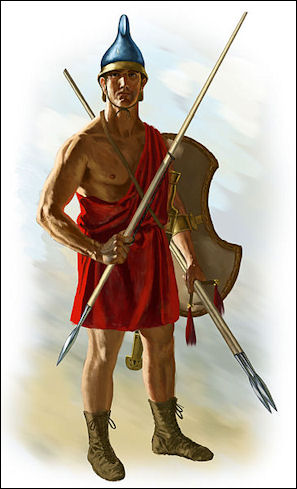
Agrianian soldier Most Greek battles consisted primarily of hand to hand combat, sword fights and eye-gouging wrestling matches. Warriors carried spears but the problem with spears is that once they were thrown at the enemy they could be picked up and throw right back. For protection Greek warriors wore an armored helmet and breastplates and carried a round shield. [Source: "The Creators" by Daniel Boorstin,μ]
John Porter of the University of Saskatchewan wrote: “In the 7th century B.C. armies came to rely more and more on a formation known as the phalanx — a dense formation of heavily-armored soldiers (known as hoplites) who would advance in close-packed ranks, each soldier holding a round shield on his left arm (designed to protect both him and the soldier to his immediate left) and a long thrusting spear in his right hand.. Unlike the older tactics, which had involved individuals battling on foot or on horseback, this style of fighting relied upon large numbers of well-drilled citizen-soldiers. The defense of the polis came to rest more on the willing participation of its propertied citizens (known, collectively, as the demos or "common people") and less on the whim of its traditional aristocracy.” [Source: John Porter, “Archaic Age and the Rise of the Polis”, University of Saskatchewan. Last modified November 2009 *]
At almost any given moment in ancient Greece at least a couple of city-states were battling one another. Attacks could come at any moment, and one reason the Greeks valued athletic events like the Olympics is that they made sure citizens were in good physical condition if or when an invasion came. Daniel Mendelsohn wrote in The New Yorker, “Until the Peloponnesian War, warfare among the various Greek city-states had for centuries been a regular, predictable affair — part of the rhythmic cycle of the season. You planted your crops, went to do battle with this or that enemy, and (you hoped) were home for the harvest. The entire war, usually a matter of some disputed bit of borderland, would be decided in a single battle fought in a single day.”
In recent years interest in the ancient Greek military has taken the form of people donning hoplite armor and taking up Spartan weapons. Re-enactments of key Greek battles and fighting methods are periodically staged. Some military buffs have even gone as far as seeking Greek residency so they can be near the places where famous battles took place and Greek soldiers lived.
See Separate Articles on The Spartans
Websites on Ancient Greece: Internet Ancient History Sourcebook: Greece sourcebooks.fordham.edu ; Internet Ancient History Sourcebook: Hellenistic World sourcebooks.fordham.edu ; BBC Ancient Greeks bbc.co.uk/history/; Canadian Museum of History historymuseum.ca; Perseus Project - Tufts University; perseus.tufts.edu ; ; Gutenberg.org gutenberg.org; British Museum ancientgreece.co.uk; Illustrated Greek History, Dr. Janice Siegel, Department of Classics, Hampden–Sydney College, Virginia hsc.edu/drjclassics ; The Greeks: Crucible of Civilization pbs.org/empires/thegreeks ; Oxford Classical Art Research Center: The Beazley Archive beazley.ox.ac.uk ; Ancient-Greek.org ancientgreece.com; Metropolitan Museum of Art metmuseum.org/about-the-met/curatorial-departments/greek-and-roman-art; The Ancient City of Athens stoa.org/athens; The Internet Classics Archive kchanson.com ; Cambridge Classics External Gateway to Humanities Resources web.archive.org/web; Ancient Greek Sites on the Web from Medea showgate.com/medea ; Greek History Course from Reed web.archive.org; Classics FAQ MIT rtfm.mit.edu; 11th Brittanica: History of Ancient Greece sourcebooks.fordham.edu ;Internet Encyclopedia of Philosophy iep.utm.edu;Stanford Encyclopedia of Philosophy plato.stanford.edu
Book: “ Warfare on the Classical World” by John Warry.
Ancient Greek Soldiers
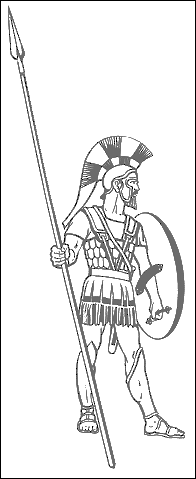
Hoplite The Greeks had a reputation of being fierce fighting men. The Persians hired Greek mercenaries in their conquest of Persia in 550 B.C.. Many of the soldiers in the Peloponnese War were unemployed soldiers put out of work by the ending of hostilities between the city states. [Source: "History of Warfare" by John Keegan, Vintage Books]
Young men were assigned to a military duty of two years when they turned 18. Often they were sent to the frontiers of Attica. At the age of 17 sons from prosperous families were recruited as soldiers and trained in athletics, hunting and mock warfare. Those that didn't make the grade had their rights reduced and those that graduated, at the age of 19, starting living with other men and participating in battles when the need arose. The families of married soldiers lived apart.
Every citizen under 60 could be called up for military service. Greek-farmer citizen soldiers usually fought among themselves, but could be united against an external threat like the Persians. The Greek citizen soldier were not paid a wage like Roman soldiers, they fought on their own behalf to protect land they owned.
The typical Greek soldier was a hoplite with a spear. In the navy there were oarsmen and marines. The hoplites were the world's first known citizen soldiers. They owned land, bought their own armor, and voted, giving them a voice in the states that they protected.
Soldiers occupied the upper level of society. "My wealth is spear and sword," went one Cretan drinking song," and the stout shield which protects my flesh; with this I plow...with this I am an entitled master of the serfs.” The 7th century solider-poet Archilochos wrote: "I am two things: a fighter who follows the Master Battles, and one who understands the gift of the Muses' love."
To get a sense of what it was really like to be a Roman soldier, German historian Marcus Junkel and a handful of colleagues donned Roman garb and rode on horseback over the Alps, along the Danube, and beside the Mediterranean. Perhaps the most important thing he learned from his experience was to be careful with horses and weapons. One time a horse fell on him and broke his shinbone. Another time he fell on javelin that pierced his neck. [National Geographic Geographica, October 1993.]
Ancient Greek Military Units
According to the Metropolitan Museum of Art: The hippeis ("horsemen"), earned enough from their land to maintain a horse and so fought as cavalry; the zeugitai, were able to afford the equipment of a hoplite; the wealthiest class, the pentakosiomedimnoi ("five-hundred-bushel men"), supplied the leaders for the armed forces; and the poorest class, the thetes, were hired laborers who served as oarsmen in the Athenian fleet, or as archers and light-armed men on land.
“Backed up by archers and light-armed troops, the hoplite phalanx remained the most important fighting unit for centuries. They advanced in close formation while protected by their overlapping shields. A successful battle often consisted of one phalanx, hundreds of men across and eight or more warriors deep, pushing against an enemy's phalanx until one or the other broke formation, exposing its hoplites to danger and death. \^/
Archeologist can sometimes determine the military specialities of soldiers by their remains. Archers tend to develop asymmetrical bone growths on their right shoulder joints and left elbows. Hoplites (armed spearmen) carried large round shields that weighed up to 14 pounds on their left arms. Such burden sometimes leave skeletal traces. The remains of soldiers also often supply evidence of severe traumas that killed them such as sword cuts and arrow strikes. Graves in Himera Sicily have revealed soldiers buried with iron spear heads lodged in their bodies. Arrowheads often provide evidence that allows archeologist to determine where the soldiers originated.
Athenians argued whether it was acceptable to massacre opponents. In 416 B.C., under the Alcibiades, they invaded the island of Melos, killing all the men and enslaving everyone else for the crime of being neutral. For many historians this event was the watershed of Athens’s moral decline. The Spartans also used underhanded tactics. After Athens attacked the Spartan port of Gytheion and set fire to Spartan ships, Spartan soldiers retaliated by disguising themselves as visiting athletes and retook the port. See Peloponnesian Wars.
Hoplite Phalanx
Professor Daniel Moran wrote for the BBC: A seventh-century B.C. pottery jug from Corinth, in ancient Greece “provides the earliest known illustration of the hoplite phalanx, a dense formation of heavily armed infantry. This kind of formation became characteristic of the armies of the ancient Greek cities at about the time the jug was made. [Source: Professor Daniel Moran, BBC, February 17, 2011 |::|]
“Hoplites acquired their name from their round wooden shield, the hoplon. This shield, together with a brass helmet, breastplate, greaves, a nine-foot spear designed for thrusting, and a short iron sword as a reserve weapon, constituted the hoplite's panoply (his complete armour and weaponry). Membership in the phalanx was confined to those male inhabitants of a city who could afford such relatively elaborate equipment. |::|
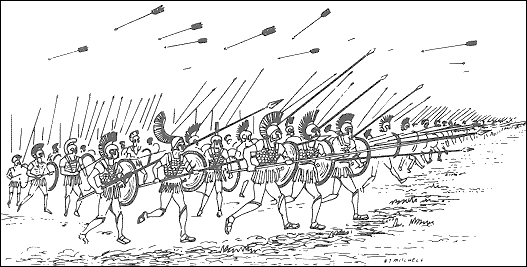
phalanx
“Prior to the advent of the phalanx, ancient warfare featured individual combat between aristocratic champions on the one hand, and mass confrontations between loosely-organised mobs on the other. Compared to these immemorial methods, the advantages afforded by the phalanx were partly psychological. |::|
“Hoplites advanced shoulder-to-shoulder in tight columns that were normally eight rows deep, a formation that was both reassuring to its members and intimidating to those awaiting its approach. Such a mass could move at no more than a moderate walking pace - the illustration on the jug includes a piper, who helped the warriors keep in step - but even so an advancing phalanx could deliver a considerable shock, sufficient to shatter a less rigorously organised opponent. |::|
“Given that only the first one or two rows of hoplites could have hoped to employ their weapons, combat between opposing phalanxes must have amounted to highly ritualised, intensely lethal shoving matches, in which those in the front ranks were pushed forward by their comrades in the rear. |::|
“In such circumstances the skill and bravery of individuals would have counted for less than the discipline of the group. The phalanx was thus a natural military expression of the democratic ethos of the Greek cities. Its cohesion and strength were rooted in, and gave form to, the communal values and civic equality of its citizen-soldiers.” |::|
Ancient Greek Armor and Weapons
The main hoplite weapon was an eight- to ten-foot thrusting spear with an iron tip and butt.For protection Greek warriors wore an armored helmet and breastplates and carried a three-foot-across round shield called a “ hoplon”. Greek soldiers supplied their own armor: bronze helmet with nose and cheek pieces, breastplate, greaves (for the arms and legs below the knee), a heavy shield made of bronze or wood reinforced with iron, circular or elliptical, attached to the left arm, The armor, which together weighed about 70 pounds, protected them from cavalry charges and archers.
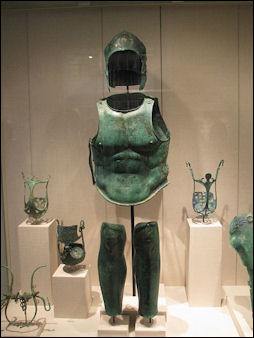
armour According to the Metropolitan Museum of Art:: Hoplites “were characteristically equipped with about seventy pounds of armor, most of which was made of bronze. The typical panoply...and bronze armor consisting of a helmet, cuirass (chest armor), greaves (shin guards), and a large shield about thirty inches in diameter. The heavy bronze shield, which was secured on the left arm and hand by a metal band on its inner rim, was the most important part of a hoplite's panoply, as it was his chief defense.” [Source: Department of Greek and Roman Art, Metropolitan Museum of Art, October 2000, metmuseum.org \^/]
The earliest armor was made hides or fabric, such as linen, that was quilted for strength. A 14-layer linen fragment has been found that dates back to the 16th century B.C. Some soldiers were buried wearing a helmet and a golden mask. Rigid scale armor made from metal, bone, wood or cir boulilli (leather made hard by boiling in wax) was used by the ancients Greeks and Romans. Detailed descriptions of armor from the Greek and Roman period have survived but actual pieces of armor are very rare.
Many soldiers were outfit with a nine-foot spear (a wooden shaft with an iron point) and a short straight sword. There were also units of archers, perhaps using poison-tipped arrows. In the legend of Hercules there is story of how the hero defeated the multi-headed Hydra with flaming arrows dipped in pitch and there after kept poison collected from Hydra’s body and used that to poison his arrows. The word toxin is derived from the Greek word for arrow.
City states were walled. Under the guidance of the tyrant of Dionysuis I, engineers in Syracuse developed the catapult. "The catapult had an effective distance of up to 50 meters," a German archaeologist told National Geographic, "It could hurl not only stones but also arrows. No longer did people have to fight person-to-person. Catapults were moved across field on top of towers ten meters high. That was tall enough to attack an enemy inside his own walls."
Dionysius is also credited with using 60,000 men and 6,000 oxen to build a wall around Syracuse to protect it from a Cathaginian attack. The 20-foot-thick wall still stands on the northern edge of Syracuse.
Bone, Hoof and Wood Weapons and Armor
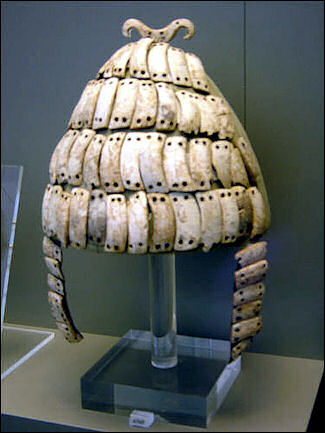
Boar tusk helmet Pausanias wrote in “Description of Greece”, Book I: Attica (A.D. 160): Among the votive offerings there is a Sauromatic breast plate. On seeing this a man will say that no less than Greeks are foreigners skilled in the arts. For the Sauromatae have no iron, neither mined by them selves nor yet imported. They have, in fact, no dealings at all with the foreigners around them. To meet this deficiency they have contrived inventions. In place of iron they use bone for their spear-blades, and cornel-wood for their bows and arrows, with bone points for the arrows. They throw a lasso round any enemy they meet, and then turning round their horses upset the enemy caught in the lasso.
Their breastplates they make in the following fashion. Each man keeps many mares, since the land is not divided into private allotments, nor does it bear any thing except wild trees, as the people are nomads. These mares they not only use for war, but also sacrifice them to the local gods and eat them for food. Their hoofs they collect, clean, split, and make from them as it were python scales. Whoever has never seen a python must at least have seen a pine-cone still green. He will not be mistaken if he liken the product from the hoof to the segments that are seen on the pine-cone. These pieces they bore and stitch together with the sinews of horses and oxen, and then use them as breastplates that are as handsome and strong as those of the Greeks. For they can withstand blows of missiles and those struck in close combat.[1.21.7] Linen breastplates are not so useful to fighters, for they let the iron pass through, if the blow be a violent one. They aid hunters, how ever, for the teeth of lions or leopards break off in them. You may see linen breastplates dedicated in other sanctuaries, notably in that at Gryneum, where there is a most beautiful grove of Apollo, with cultivated trees, and all those which, although they bear no fruit, are pleasing to smell or look upon.
Alexander the Great's Army and Weapons
Alexander’s army was made up of around 50,000 men (an enormous number at that time when great cities had a population of 10,000 or 20,000). Most were Macedonians or hired Greek mercenaries that were paid in booty from the conquests. As time went on the Greeks were dropped and the army was made up mostly of Macedonians or subjects of the most recently conquered territory. Cambridge historian Nicholas Hammond told National Geographic, "Alexander kept his army supplied by recruiting from the enemy. The fact that he could successfully do this speaks volumes about his leadership."
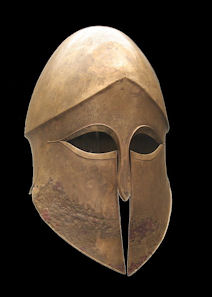
Corinthian_helmet Alexander’s force is regarded as the first professional army. At the vanguard were the Companions, an elite highly-skilled cavalry force, and the Macedonian phalanx, a high mobile unit of foot soldiers with long pikes. Cavalry made up about a sixth of the army. The Macedonians had a much more developed cavalry than the Greeks in part because Macedonia had more grasslands to feed horses. Genghis Khan and Alexander had similar-sized armies.
Among the foot soldiers were archers, equipped with short bows; Greek hoplites, skilled veteran soldiers; shield bearers, who carried weapons and assisted the hoplites; slingers, who threw stones with slings; and trumpeters who relayed messages on the battlefield.
Supplying an army of 50,000 men was no easy task. Alexander employed bullocks and oxen (young and old castrated bulls) to carry the supplies, and the tactical range of his army was eight days, the maximum length of time in which an ox can carry supplies and food for itself. Campaigns of longer duration had to stay near ports (where food could delivered) or at settlements that were large enough to supply Alexander's army with what it needed. [Source: "History of Warfare" by John Keegan, Vintage Books]
Alexander’s soldiers relied on the “sarissae”, or pike, a 4.3-meter-long spear that was twice as long as a standard spear. Archers used powerful short bows. Slingers threw stones to harass the enemy. Soldiers were armed with swords and wore armored helmet and breastplate like the Greeks and used a round shield for protection. The cavalry rode horses with rudimentary saddles with no stirrups.
While the Persians and others relied on long bows the Greeks amd Macedonians were primarily hand-to-hand combatants who relied on swords and thrusting pikes. Sarissae were wooden pikes. They were generally around three meters longer than the average spear and this gave them a range advantage.
Ancient Greek Biochemical Weapons
The Greeks reportedly objected to the use of toxic weapons and underhanded fighting methods because pf their sense of a “fair fight.” Even so they did things like dump rotting animals into the wells and catapulted plague and smallpox victims over the walls of their enemies. Some scholars believe that they tipped arrows with snake venom and that poison arrows may have played a role in the outcome of the Trojan War. Homer described black blood flowing from wounds and the use of leeches to suck the blood from such wounds. There were clear signs of snake poisoning.
Spartans used sulphur and pitch in warfare and created poison gas and a flame throwing machine to attack fortified positions in the Peloponnesian War. Thucydides described the Spartan use of incendiary weapons as the "most devastating manmade conflagration ever seen" in their attempt to destroy the city of Platania in 430 B.C. They used a flaming mixture of pitch and sulfur against the Athenians at Delium in 424 B.C.
In the 4th century B.C. Aeneas the Tactician’s book on surviving sieges devoted a whole section to fending off chemically-enhanced fires. One of his chief recommendations was to fight the fire with fire by pouring pitch on enemy soldiers or their siege machines, followed by bunches of hemp and lumps of sulfur, and then using flaming bundles of kindling to ignite them.
Book: “ Greek Fire, Poison Arrows & Scorpion Bombs: Biological and Chemical Warfare in the Ancient World” by Adrienne Mayor (The Overlook Press).

Battles in Ancient Greece
Greek battles were fought on foot at designated sites agreed upon in advance. Before the battle began each side ate a big meal, sacrificed a sheep and drank large quantities of wine. The battles often lasted until one side conceded defeat. [Source: "History of Warfare" by John Keegan, Vintage Books]
The objective of a battle, when Greek warfare first evolved, was perhaps to starve the enemy out of the valley so that it could be occupied. The victors achieved this by burning the grain fields and tearing up hardier grape vines and olive trees of the looser. This face to face method of fighting evolved, argues historian Victor Hanson, to make battles quick and decisive so that the enemy would not have time to burn their fields and engage in the more time consuming task of tearing up hardy grape vines and olive trees. Armies also did not want to spend so much time fighting that their crops rotted in the fields before they came back. [Source: "History of Warfare" by John Keegan, Vintage Books]
Before the battle began a no man's land of a 150-yards separated the two armies. With very few preliminaries, the two armies drove forwards at one another like two parking lots of cars headed for a head-on collision. The soldiers poked their spears towards at any piece of flesh they could find — the groin, throats or armpits — and the idea was to breach the shield wall or push the opponents backwards. Panic had a cascading effect. Once the ranks started to break up and soldiers turned around in fear, the soldiers behind them were more likely to panic. This in turn exposed more flesh at which their opponents could aim their spears, and defeat usually proceeded quickly. Most battles lasted no more that an half-an-hour to an hour, with the retreating soldiers often dropping their heavy armor so they could run away. [Source: "History of Warfare" by John Keegan, Vintage Books]
Many soldiers died during the battle and many more were claimed later by peritonitis (inflammation of a layer around the bone) through spear wounds. Generally the losing army was not pursued and the dead were exchanged under a truce. Greek custom dictated that all soldiers who died in battle were expected to receive a proper burial. [Source: "History of Warfare" by John Keegan, Vintage Books]

Ancient Greek Military Tactics
Unlike their predecessors — the Mesopotamians, Egyptians and Chinese, who maneuvered from a distance with chariots and archers — the ancient Greeks fought ace to face in tightly grouped ranks of soldiers called phalanxes. During the Trojan war chariots were used mainly as transport vehicles. One of the reasons for this was the rugged Greek countryside did not provide enough grazing land to feed a lot of horses, nor did it lend itself to chariot battles which need a lot of flat open space. [Source: "History of Warfare" by John Keegan, Vintage Books]
John Porter of the University of Saskatchewan wrote: “In the 7th century B.C. armies came to rely more and more on a formation known as the phalanx — a dense formation of heavily-armored soldiers (known as hoplites) who would advance in close-packed ranks, each soldier holding a round shield on his left arm (designed to protect both him and the soldier to his immediate left) and a long thrusting spear in his right hand.. Unlike the older tactics, which had involved individuals battling on foot or on horseback, this style of fighting relied upon large numbers of well-drilled citizen-soldiers. The defense of the polis came to rest more on the willing participation of its propertied citizens (known, collectively, as the demos or "common people") and less on the whim of its traditional aristocracy.” [Source: John Porter, “Archaic Age and the Rise of the Polis”, University of Saskatchewan. Last modified November 2009 *]
Later, the object was to build a "league of allies." "Subjecting opponents to domination," the Greeks believed, was something that barbarians did. "The 'idea' of military decision," writes historian Jack Keegan, "thus planted itself in the Greek mind beside those other ideas of decision — by majority in politics, of an outcome by inevitability, of a plot in drama, of conclusion by logic in intellectual work — we associate with our Greek heritage." The Greeks invented the notion of the decisive battle. [Source: "History of Warfare" by John Keegan, Vintage Books]
Armies traveled with sheep which provided food and cloth. The animals were often sacrificed at special points along the way.
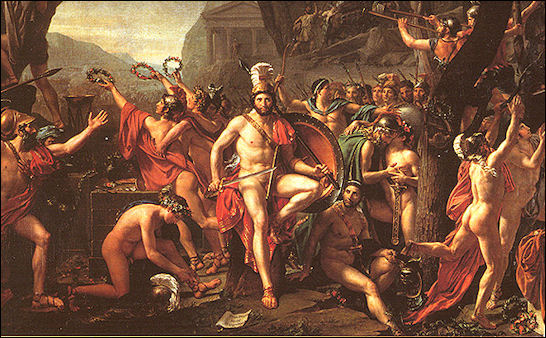
Thermopylae
Ancient Greek Fighting Tactics
Warriors carried spears but once they were thrown they were gone, unless a warrior could pick up another one. Rocks were also thrown. "Hoplite warfare" was a common tactic starting around 700 to 600 B.C. A Hoplite was a massed phalanx of armed men in close formation that bullied its way through the enemy line, causing disarray. For this method of warfare to work, each individual had to be in good condition to hold the line..↔ [Source: "The Creators" by Daniel Boorstin,μ]
Homer wrote in “The Iliad” (c. 750 B.C.): “He spoke and dashed Peisandros from his chariot to the earth, smiting him with his spear upon the breast, and he lay supine upon the ground. But Hippolochos rushed away, and him too he smote to earth and cut off his hands and his neck with the sword, then tossed him like a ball of stone to roll through the throng. Then he left them, and where thickest clashed the battalions, there he set on and with him all the well-greaved Achaians...And the Lord Agamemnon, ever slaying, followed after. [Source: Fred Morrow Fling, ed., “A Source Book of Greek History,” Heath, 1907, pp. 17, 56-58]
Soldiers stood shoulder to shoulder, usually eight rows deep, with their shield in their left hand and their spear, projected forward, held with the right hand and tucked between the elbow and ribs. The entire phalanx tended to move to the right as each man tried to get close to the protection of his neighbor's shield. [Source: "History of Warfare" by John Keegan, Vintage Books]
Greek hoplites were not successful because they were skilled swordsmen or brave but because they kept their ranks and attacked in unison. At the Battle of Cunaxa, in 401 B.C., it was reported, the Greeks slaughtered the Persians without suffering a single fatality.
Alexander the Great as a Military Leader
Alexander was a superb military commandeer. Believing himself invincible and specially blessed by the gods, he often led the cavalry charges himself, which often proved decisive, and often wore an easy-to-spot white-plumed helmet. He suffered severe sword, lance, arrow and knife wounds. Alexander once told his men, "There is no part of my body...which has not a scar...and for all your sakes, for your glory and your gain."
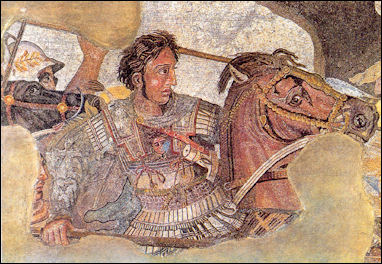
Alexander “As a warrior and a strategist, no one compares with Alexander,”Alexander biographer Lane Fox told Smithsonian magazine, “He would have made mincemeat of any Roman who came over the hill. Julius Caesar would’ve gone straight back home as fast as his horse could carry him.” And Napoleon? “Alexander would’ve wiped him out too. Napoleon only fought dodos.”
Alexander had full confidence that his men would follow him. Admiral Ray Smith, a former Navy SEAL told National Geographic, "We have learned that the key to leadership under the toughest possible circumstances is that officers and men undergo the same training. Men know their officer is not asking them to do anything he couldn't do or hasn't done."
Arrian wrote: “The sheer pleasure of battle, as other pleasures are to other men, was irresistible” to Alexander. Once, while fighting at a fortress in Multan, in present-day Pakistan, Alexander found himself stranded without a ladder. Instead of leaping outside the walls to safety he jumped inside where he was surrounded by enemies and fought off his attackers until help arrived. During the clash he sustained a nearly fatal arrow wound that may have punctured his lung. When doctors insisted that officers hold him down to prevent him from squirming while they removed the arrow head Alexander insisted that wasn’t necessary and lay still as doctors cut deeply into his chest to remove the embedded weapon.
Alexander also showed great compassion for his men. "For the wounded he showed deep concern," wrote Arrian. "He visited them all and examined their wounds, asking each man how and in what circumstances his wound was received, and allowed him to tell his story and exaggerate as much as he pleased."
Alexander the Great’s Military Tactics
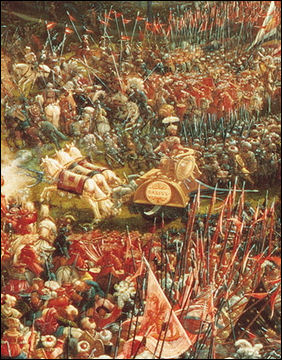
Battle of Issus Alexander liked to strike quickly. Some credit him with perfecting the cavalry charge. He often ignored the advise of his generals who advised caution and seemed little worried if his enemies held the high ground or some other advantageous military position.
At the heart of Alexander’s army were rows of disciplined soldiers with pikes, spears and swords that were organized into a “phalaiazn” and were capable of overpowering far larger enemy groups. The front rows were armed with sarissaes which had a longer reach than their opponents. Rear troops pushed forward and helped the front-row troops press ahead. Archers, slingers and cavalry attacked and defended the sides.
Foot soldiers in Alexander the Great's army learned to withstand chariot advances by aiming their weapons at the horses first: by employing arrow-proof armor and shields; and by organizing themselves into tight chariot-proof ranks.
Alexander conducted at least 20 sieges, but none within Persia because the empire was supposedly guarded from its perimeter. The three main battles — Granicus, Issua and Guagamale — were fought in open country.
Alexander relied heavily on spies. He also purportedly spied on his own soldiers by intercepting their outgoing mail. According to legend, Alexander was the first commander to require that all of his soldiers be cleanly shaven. This was so that enemies could have nothing to hold on to. ◂
Civilians were often targeted, especially in Lebanon and the Indus Valley, where large number of innocent people were killed for no military reason. The historian Ernst Badian told National Geographic, "Blood was the characteristic of Alexander's whole campaign. There is nothing comparable in ancient history except Caesar in Gaul."
Ancient Greek Fighting Ships
Greek fighting ships were built of wood and had shelters to protect the crew from the fierce Mediterranean sun. Over the open sea they traveled using hand-woven square sails. The oars were mainly for powering and maneuvering the ships in battles. At the bow was a bronze ram that was used to batter and pierce enemy ship's sides and sink it. Their main objective was to clear away enemy ships so an army could land. [Source: Timothy Green, Smithsonian magazine, January 1988.
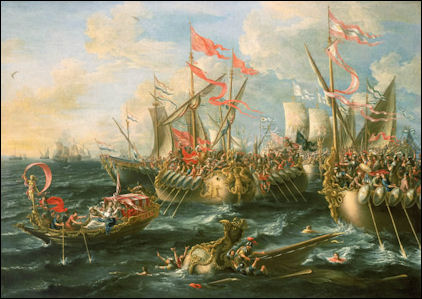
Battle of Actium Between 1150 B.C. and 850 B.C., the first ships with battering rams appeared and they shaped the way naval battles were fought for the next 1,500 years. The bow-based bronze rams transformed galleys from troop transports and coastal raiders into ships that were capable of fighting at sea. The "rams forced the construction of heavier vessels, and the tactics of ship-to-ship combat favored the development of faster and more maneuverable boats."
Biremes (galleys with double banks of oars) first appeared 700 B.C. Triremes (galleys with triple banks of oars) first appeared 500 B.C. but the cost of building them was so great that they were not widely used until around the time of Alexander (the 4th century B.C.). Not much is known about the designs of these ships other than what can be gleaned from historical accounts and few images on vases. No remains of a trireme have ever been found.
Triremes were used by Athenians to defeat the Persians at the Battle of Salamis in 480 B.C. A typical trireme is thought to have been a 118-foot-long vessel powered by sails and 170 oars mounted on three decks. The oars came in two lengths — 13 feet and 13 feet and 10 inches — and the oar holes were large enough for a man's head (a punishment that sometimes befell unruly oarsmen).
Triremes cruised at a speed estimated at between 7 and 12½ knots. They carried only 14 soldiers and a crew of 17 to go along with the 170 oarsmen. This because by the time they became widely used they were no longer troop carriers but were full-blown naval fighting ships. Triremes were made for day use only. There were no facilities on them for eating or sleeping.
Large Ancient Greek Ships
As time went the ships became larger and larger. Galleys rated as "fours," "fives," and "sixes" were introduced between 400 B.C. and 300 B.C. They were followed up by "16s," "20s" and "30s." The Emperor Ptolemy IV built a massive "40." The numbers refereed to the number pulling each triad of oars. Ships with more than three bank were built but ultimately they proved to be impractical.
Describing one of the largest boats, a 2nd century Greek wrote: "It was [420 feet] long, [58 feet] from gangway to plank and [72 feet] high to the prow ornament...It was double-prowed and double-sterned...During a trial run it took aboard over 4,000 oarsmen and 400 other crewmen, and on deck 2,850 marines."
In the late 1990s an English-Greek team built a 170-oar trireme at a cost of around $640,000. Held together with 20,000 tenons fastened with 40,000 oak pegs, it set sail with a an international crew of 132 men and 40 women. Describing, the team in action, Timothy Green wrote in Smithsonian, "the crew rowed together and sang together, getting up high spirits and up to seven knots.
Ancient Greek Ship Rowers
Contrary to the popular myth Greek fighting ships were not manned by slaves, who were thought to be untrustworthy and expensive (they had be fed year-round even though a ship only operated about half the year). Instead they were manned by free citizens who sat on three levels.
The oars were secured with leather straps. The rowers had to learn to row in unison so their oars didn’t collide. One rower said, "Because there are only nine inches between the blades any tiny discrepancy in a stroke caused one blade to hit the next and, and so on in a domino effect." When it is working well it was "like a centipede, with all oars moving beautifully."
The rowing stations at the center of the ship were best because if a oar is viewed as a lever and the oar hole is the fulcrum. According to the laws of mechanics the further one is away from the fulcrum the easier is to lift the object — or in the case of the oar, push the water.

Ancient Mechanical Artillery
Ancient Greek Sea Battles
In naval clashes, the Greeks preferred oared vessels over sailing ships because they were more maneuverable. Ships were used in conjunction with land forces to cut off coastal towns and keep large armies from landing. Almost all great naval battles from Salamis in 480 B.C. to Lepanto in and 1571 — were fought within sight of land.
Maneuverability was an asset because naval clashes were essentially hand-to-hand land battles on water. Some of ships were outfitted with a battering ram bow and rowers who were stronger to propel their boat forward with enough force to sink with a broadside thrust on an enemy ship. [Source: "History of Warfare" by John Keegan, Vintage Books]
Sea battles and commerce usually only took place in the summer. During the winter the seas were too stormy and rough. The Battle of Salamis defeat of Persian invasion in 480 B.C. is one of the most important events in world history. See History
Aristophanes wrote: "When there is a threat of war, you didn't sit quiet; but in a moment you be launching 300 ships and the city would be full of the hubbub of servicemen, or shouts for... wage-paying...Down in on the dockyard the air would be full of the planing of oars, the hammering of dowel pins, the fitting of oarports with leathers, or popes, bosn's, trills and whistles."
Greek Fire and Flame Throwers
The Byzantines discovered that by adding sulphur or quicklime and saltpeter to naptha they could create a material capable of spontaneous combustion and produce bombs that could be thrown at enemies that would explode on impact. This napalm-like "Greek fire" was used in A.D. 673 and 678 to fend off attacks on Constantinople by Arabs.
In 10th century the Byzantines invented the flame thrower, a powerful secret weapon that changed the nature of warfare. The devise used Greek fire that was preheated under pressure and discharged in liquid form with pump-powered, syringe-like bronze tubes. It was used primarily in sea battles, when it incinerated wooden ships and their crews and even spread fire on the water. Russia's Prince Igo purportedly lost 10,000 vessels to Greek fire in a battle in 941.☼
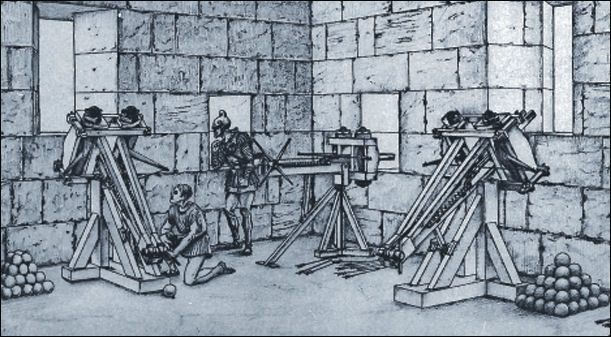
Hellenistic Artillery Tower Reconstruction
Fire weapons made Byzantine ships masters of the sea for centuries. Byzantine war ships were outfit with catapults used to fire "Greek fire" grenades and cannons. Greek Fire was also used on land: pressurized siphons were fired at forts, squirt guns and ceramic hand grenades were used at close range in hand-to-hand battles,
The recipe for Greek Fire was a carefully guarded secret. It is believed that early versions were devised by Callinicus, a A.D. seventh-century engineer from Syria, where people had been using flammable petrochemicals for some time. Scholars are still not sure of the ingredients. It was likely a highly combustible mixture of quicklime, sulphur, naptha and saltpeter. It was particularly nasty because it clung to whatever it touched and was not quenched by water. Clothing and ship sails were often ignited and people could not put out the fires by jumping into the sea.
The use of Greek Fire was regarded with horror and moral disgust. There is no mention of it from A.D. 800 and 1000 and some scholars believed it may have been banned because it was "too murderous."
Image Sources: Wikimedia Commons, The Louvre, The British Museum
Text Sources: Internet Ancient History Sourcebook: Greece sourcebooks.fordham.edu ; Internet Ancient History Sourcebook: Hellenistic World sourcebooks.fordham.edu ; BBC Ancient Greeks bbc.co.uk/history/ ; Canadian Museum of History historymuseum.ca ; Perseus Project - Tufts University; perseus.tufts.edu ; MIT, Online Library of Liberty, oll.libertyfund.org ; Gutenberg.org gutenberg.org Metropolitan Museum of Art, National Geographic, Smithsonian magazine, New York Times, Washington Post, Los Angeles Times, Live Science, Discover magazine, Times of London, Natural History magazine, Archaeology magazine, The New Yorker, Encyclopædia Britannica, "The Discoverers" [∞] and "The Creators" [μ]" by Daniel Boorstin. "Greek and Roman Life" by Ian Jenkins from the British Museum.Time, Newsweek, Wikipedia, Reuters, Associated Press, The Guardian, AFP, Lonely Planet Guides, “World Religions” edited by Geoffrey Parrinder (Facts on File Publications, New York); “History of Warfare” by John Keegan (Vintage Books); “History of Art” by H.W. Janson Prentice Hall, Englewood Cliffs, N.J.), Compton’s Encyclopedia and various books and other publications.
Last updated October 2018
